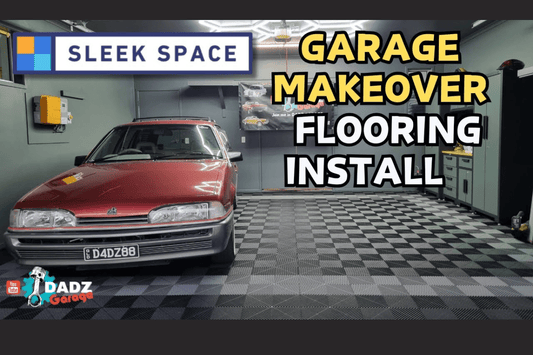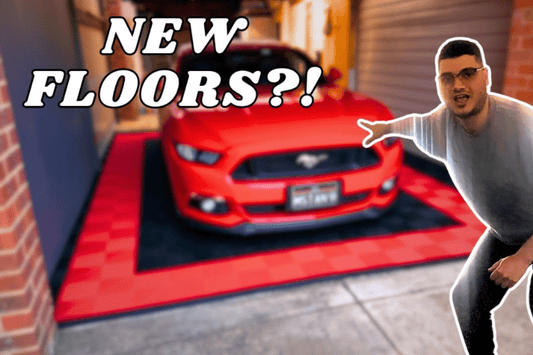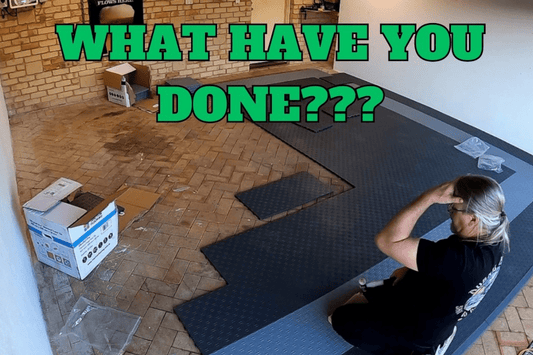Are Garage Floor Tiles Waterproof?

One of the most common questions people ask before transforming their garage is, “Are garage floor tiles waterproof?” The answer sounds simple, but the reality is more nuanced. In garages, waterproofing isn’t just about repelling water — it’s about how the entire floor system manages moisture, airflow, and longevity over time.
At Sleek Space, we view waterproofing as part of intelligent design, not an optional feature. It begins with the material itself, continues through the interlocking structure, and ends in how the tiles handle the subtle movement of air and water beneath the surface. This guide explores what true waterproofing means for a garage floor, the differences between solid and vented tiles, and how to make sense of claims that often oversimplify the idea.
What “Waterproof” Really Means in a Garage Environment
In domestic spaces, waterproofing usually means a sealed surface that doesn’t let water through. In garages, conditions are different. Floors face constant cycles of moisture — wet tyres, car washing, and weather tracking through open doors. The goal isn’t to seal everything tightly; it’s to prevent water from doing damage or lingering where it shouldn’t.
A truly waterproof garage floor manages water intelligently. It keeps the surface stable, allows incidental moisture to evaporate, and ensures the concrete underneath can breathe. The emphasis is on moisture control rather than complete isolation — a distinction that separates long-lasting floors from those that peel, bubble, or develop mould underneath.
Material: The Core of Water Resistance
Every waterproof floor begins with the right material. Sleek Space tiles are made from virgin polypropylene copolymer — a dense, non-porous polymer that does not absorb water. It remains dimensionally stable under heat and pressure, and it doesn’t soften or discolour when wet. Polypropylene’s surface is also chemically inert, meaning oil, detergent, and brake fluid can’t penetrate or stain it easily.
Recycled or mixed plastics often tell a different story. They may look similar, but recycled blends introduce micro-pores that act like tiny sponges for moisture and contaminants. Over time, those pores lead to dulling, staining, and odour — clear indicators that the material has interacted with water. Virgin-grade polymer avoids those weaknesses, ensuring that waterproof performance comes from structure, not coating.
Design: How Interlocking Tiles Handle Water
Material quality is only half the equation. The other half is how the tiles connect. Sleek Space systems use a precision interlocking mechanism that creates a consistent, tightly aligned surface. When tapped into place with a rubber mallet, the tiles form an even plane with minimal visible gaps. Yet crucially, this design still allows the subfloor to breathe.
Under each tile is a grid network of ribs that lift it slightly off the concrete. This small elevation prevents standing water from getting trapped and lets air circulate underneath. When water finds its way beneath — through condensation, cleaning, or rain from car tyres — those channels help it dry naturally. Instead of trapping moisture, the floor quietly regulates it.
This is where many “waterproof” claims fall short. A fully sealed surface might sound ideal, but sealing concrete completely can cause water vapour to accumulate and damage both the slab and any coating on top. The best garage floors don’t block water — they balance it.
Solid vs Vented Tiles: How Each Manages Moisture
Sleek Space offers both solid and vented tile designs, and understanding the difference is essential when thinking about waterproofing.
Solid Tiles
Solid tiles, such as ULTRATUFF™, feature a continuous surface that stops spills and splashes from passing through to the subfloor. They are excellent for garages where cleanliness and containment matter. However, it’s important to recognise that “solid” doesn’t mean “sealed.” Water can still reach the seams between tiles, and if it does, it will drain or evaporate through the small gaps designed into the system.
The surface itself is waterproof, but the floor as a whole remains breathable. That’s intentional. A fully sealed, non-breathing surface over concrete can trap vapour from below, eventually leading to bubbling or odour. By allowing microscopic airflow through the jointing system, the tiles maintain both waterproof performance and long-term stability.
Vented Tiles
Vented tiles, such as ULTRAGRID™ or ULTRACORE™, handle water differently. Their open-rib design lets liquids pass through instantly, so the surface never becomes slippery. Any water underneath can then evaporate naturally through the channels between ribs. This makes vented tiles ideal for garages exposed to rain, wash-downs, or frequent moisture. They are technically “self-draining” rather than sealed, but in practical use, they deliver a more effective kind of waterproofing — one that keeps both the surface and subfloor dry.
In essence, solid tiles protect from above, while vented tiles regulate from below. Both are waterproof in their own way — one by containment, the other by continuous air exchange. The right choice depends on how your garage is used and how water typically enters the space.
Surface Texture and Safety When Wet
Waterproof performance also depends on surface behaviour. A floor that repels water but becomes slick when wet isn’t practical. Polypropylene’s natural texture provides slip resistance without needing added coatings. Each Sleek Space tile has a matte finish that disperses light and maintains traction, even in wet conditions.
This combination of durability and grip makes modular tiles suitable for high traffic areas and heavy duty use — from family garages to commercial workshops. The texture also helps manage small surface droplets, allowing them to spread thinly and evaporate quickly rather than form puddles.
Moisture Management Under the Surface
Waterproofing doesn’t stop at the surface. Concrete naturally releases water vapour from below, especially in humid climates. Coatings like epoxy trap that vapour, leading to blistering or peeling. Interlocking garage floor tiles avoid this entirely by acting as a floating layer above the slab. The air gap underneath allows the concrete to release moisture safely without affecting the floor’s stability or appearance.
This small detail has a large effect. It prevents mildew growth, reduces odour, and helps maintain a more consistent temperature across the garage. It’s a subtle form of protection that works continuously without the need for maintenance or renewal.
Are All Garage Tiles Waterproof?
Many tiles are described as waterproof, but performance varies greatly. Rubber tiles resist absorption but can trap moisture in seams and eventually hold odour. Flexible PVC tiles may repel water initially but expand in heat or warp when exposed to standing moisture. In both cases, waterproofing is temporary rather than structural.
Virgin polypropylene takes a different approach. It doesn’t rely on coatings or softeners; its waterproofing is inherent to the polymer. It won’t absorb water, stain, or deform under pressure, and it remains rigid enough to maintain tight seams. That structural integrity is what allows Sleek Space tiles to perform reliably year after year, even in garages exposed to water daily.
Installation: Achieving a Watertight Fit
Installing modular tiles correctly ensures that the floor performs as intended. Begin with a clean, level concrete floor. Align the tiles row by row, clicking them together with a rubber mallet. The interlocks are engineered for precision — snug enough to prevent visible gaps, yet flexible enough to accommodate small surface irregularities.
Edges can be trimmed with a saw to fit neatly around walls, posts, or cabinetry. Once installed, the surface functions as a continuous plane that resists pooling and directs water toward natural drainage paths. There’s no adhesive, no curing time, and no risk of trapped moisture beneath a sealed layer.
Cleaning and Maintenance
Maintaining a waterproof floor shouldn’t require special products. Because polypropylene is stain resistant, most cleaning involves a broom, mop, and warm water. Oil or detergent spills can be wiped up easily without leaving marks. Unlike epoxy or painted floors, there’s no topcoat to reapply or reseal.
Both solid and vented tiles dry quickly after washing. On vented systems, water simply drains through and evaporates. On solid systems, surface water disperses evenly thanks to the matte finish. Either way, the floor returns to its clean, dry appearance within minutes.
Durability and Everyday Use
Waterproofing has little value if the floor can’t withstand daily use. Each Sleek Space tile is built to withstand heavy vehicles, tool trolleys, and storage loads without flexing or cracking. The interlocks distribute pressure evenly, so even under heavy duty loads, tiles stay aligned and stable.
Because the material itself is unaffected by moisture, it doesn’t deteriorate in damp conditions or under cleaning chemicals. This structural durability is what makes waterproofing sustainable — it lasts as long as the floor itself.
How Long Does a Waterproof Garage Floor Last?
When designed properly, modular flooring can last more than twenty years. The non-porous polymer doesn’t fade, absorb odour, or lose its interlock strength. The system’s replaceable nature also means maintenance is minimal: if one tile becomes damaged, it can be swapped out without disturbing the rest of the floor.
That longevity isn’t just about material — it’s about balance. By allowing controlled airflow and resisting water absorption, the floor maintains a stable microclimate. The concrete beneath stays dry, the surface remains intact, and the floor keeps performing quietly in the background.
Why Waterproof Flooring Matters
Waterproof flooring isn’t a luxury; it’s a foundation of reliability. A garage is constantly exposed to small amounts of moisture — the kind that, if ignored, can shorten the life of any surface. A waterproof system ensures that water, whether from rain or washing, never becomes a source of damage. It simplifies cleaning, prevents odour, and keeps the space usable all year round.
In essence, a waterproof garage floor isn’t about staying dry on the surface. It’s about managing water as part of the floor’s natural environment — channelling it, releasing it, and preventing it from becoming a problem later. That’s the quiet confidence built into every well-designed modular system.
Key Takeaway: Waterproofing Through Design, Not Promises
So, are garage floor tiles waterproof? Yes — when designed properly. Both solid and vented tiles offer protection against water, but in different ways. Solid tiles keep water above the surface, while vented tiles let it pass through and dry naturally. Neither relies on sealants, and neither needs maintenance to stay effective.
Waterproofing isn’t something you add to a tile. It’s something that happens when material, structure, and airflow work together. That’s why genuine waterproof flooring doesn’t draw attention to itself. It simply performs — quietly, consistently, and for years on end.
In Summary
Water in a garage is inevitable, but damage doesn’t have to be. The best floors don’t resist water through tight seals or glossy coatings; they manage it through engineering. Whether you choose a solid or vented design, what matters is how the system allows your space to stay balanced — dry where it should be, breathable where it needs to be. That’s waterproofing done properly.



